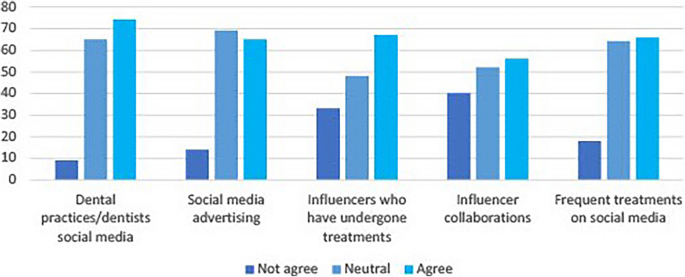Abstract
This study investigated the influence of social media on patients regarding aesthetic dental treatments according to sex, type of treatment, and time since their last treatment. A cross-sectional study was conducted using a web-based survey. Participants were students over 18 years of age who were social media users and had undergone aesthetic dental treatment. 504 responses were included. Data evaluation was made using Pearson chi-square test. The level of significance was set at p < .05. 29.37% of the respondents indicated that social media influenced their decision to have their aesthetic treatment. Regarding the influence of social media, no differences were observed between males and females, nor by type of aesthetic treatment. Participants who had undergone an aesthetic dental treatment within the last year were more influenced by social media than those who had undergone it more than two years ago. Posts from dental clinics or dentists were the type of content that most influenced participants. Social media can influence some patients' decision to undergo aesthetic dental treatment, thus dental practices and dentists should consider the increasing importance of social media in their daily practice.
Introduction
Web 1.0 initially emerged as a space for companies to disseminate information to the public1 and it was characterized by its limited scope for interactive communication with users2, as it only allowed searching and reading information1. However, the evolution of web technologies and user interfaces has significantly changed the way users interact with information3. This development has led to dynamic and interactive websites with user-oriented features, also referred to as Web 2.04, which encompasses a range of Internet applications that have fostered increased participation, collaboration, openness, and social networking2. These Web 2.0 applications include blogs, social networking platforms, and social media5. According to the Cambridge Dictionary, social media refers to `websites and computer programs that allow people to communicate and share information over the Internet using a computer or mobile phone6. Examples of social media include blogs, wikis, podcasts, Facebook, Twitter, YouTube, or LinkedIn6,7.
In recent years, there has been a significant increase in the use of social media8. Originally designed for personal use, they are now widely used by businesses to promote products or services and engage with consumers9. In the health sector, social media play a crucial role in various areas such as health promotion, research, recruitment, and marketing10. Specifically, in the field of dentistry, marketing has emerged as an additional facet to the clinical practice of dentists11. Consequently, this has led to a proliferation of oral health-related information on certain websites, aimed at promoting specific products12.
Dental websites sometimes contain posts with promotional content, often accompanied by before and after photographs13. These photographs have been found to be effective in encouraging some people to seek treatment14. In addition, advertisements related to cosmetic dentistry15 or specific publications on treatments such as tooth whitening16. As a result, social media platforms have facilitated direct access to such content, contributing to an increased demand for cosmetic dentistry17. However, the content published is not always developed by oral health professionals, but rather by users or individuals commonly referred to as influencers. In recent years, the figure of the influencer has grown as a communication method to engage directly with consumers18. For example, influencers are individuals with a large number of followers and interactions on social media19 who sometimes post content related to dentistry. It is therefore relevant to investigate the potential influence of social media in relation to aesthetic dental treatments, especially given the increasing demand for such treatments17 and the impact of website advertising on customer perceptions of oral healthcare12. This aspect is of particular importance in the young adult population, as they have a higher use of social media20. Therefore, the rationale for the study is that there is lack of scientific evidence analyzing the impact of social media on aesthetic dentistry. It is important for dentists to be aware of the impact of social media on the demand for aesthetic treatments so that they can take it into account in their daily practice. Thus, the aim of this study was to describe the influence of social media on students who had undergone aesthetic dental treatment according to sex, type of aesthetic dental treatment received and time when it was performed to explore whether social media have influenced the performance of these treatments. The null hypothesis was that there would be no significant differences in the influence of social media on young patients in terms of sex, type of aesthetic dental treatment received and when it was performed.
Methods
Study design
To conduct this cross-sectional study, the web-based questionnaire (WBQ) survey method was chosen. WBQs are self-administered questionnaires that users can access through a browser on several devices, such as computers, mobiles, or tablets21. With the increasing use of the Internet, WBQ questionnaires represent an alternative to traditional paper questionnaires22. It has been observed that this type of questionnaire is completed to a greater extent and with fewer missing items compared to paper-based questionnaires23. At present, the WBQ questionnaires have been used in various research studies24,25. Access to the survey was facilitated by a QR code. This study was conducted in accordance with the principles of the World Medical Association’s Declaration of Helsinki and was registered in Clinical Trials under ID NCT05850403 in May 2023.
Ethics committee approval
This study was approved by the Ethics Committee of the Universidad Europea de Madrid (CIPI/22.022). Data handling was carried out in accordance with the regulations (EU) 2016/679 of the European Parliament, and of the European Council 27th April 2016 on the protection of personal data, its processing and free movement. Participation in the study was voluntary and no financial compensation was provided for participation in the study.
Sample recruitment
It was calculated that a minimum of 395 surveys were required to estimate the proportion of people who reported being influenced by social media in their last aesthetic dental treatment (expected proportion: 50%) with a precision margin of 5%, a confidence level of 95% and assuming a 5% loss rate.
The target population were young social media users who had previously undergone aesthetic dental treatment. Therefore, the inclusion criteria were students over 18 years of age that accepted the informed consent. Exclusion criteria were not having social media or not having previously undergone esthetic dental treatment. The sampling method used was non-probability sampling. Participants were recruited during the celebration of an Oral Health campaign, framed within the IX Oral Health and Healthy Habits campaign of the First Region Official College of Dentists and Stomatologists on 22 and 23 March 2023. Recruitment was carried out by some volunteer students of the fourth year of the Degree in Dentistry of the Universidad Europea de Madrid, as well as by the authors of the study. A link was shared via a QR code that was displayed by volunteers and available on posters at the event.
Questionnaire
The Strengthening the Reporting of Observational Studies in Epidemiology (STROBE) checklist26 was used to design the questionnaire. The study was conducted using the Microsoft Forms platform (Microsoft Inc., Seattle, WA, USA), which did not require registration for access. For validation purposes, a first version of the questionnaire was created in Spanish, consisting of 19 questions distributed over four pages and divided into three sections. The final questionnaire was available in both Spanish and English, allowing participants to choose their preferred language.
Informed consent section. This section provided information about the aims of the study, explained that data collection would be anonymous, informed participants of their right to withdraw from the study at any time, information about the principal investigator was provided (Y.F) as well as information about the location and method of storage of the data collected. Consent was obtained through a dichotomous question (yes/no). Only participants who responded affirmatively to this question were included in the study.
Sociodemographic characteristics section. First, an open question asked for a nickname. Then, age was asked with a closed polytomous question (18–25; 26–35; > 36) and sex (male, female), being a student (yes/no) and having had aesthetic dental treatment (yes/no) were asked with dichotomous questions. Participants were then asked about the most recent dental treatment (orthodontic treatment; invisible orthodontic treatment; teeth whitening; veneers or crowns; other treatment) and when it was received (less than one year ago; within the last two to five years; more than six years ago) using two closed polytomous questions.
Participants’ social media behavior section. Participants were asked if they had a social media account (response: yes/no). If they answered yes, they were asked about their general use of social media through four closed, polytomous questions:
-
Social media platforms on which they had an account (response: Facebook; Instagram; Twitter; LinkedIn; TikTok; Snapchat)
-
Most frequently used social media (response: Facebook; Instagram; Twitter; LinkedIn; TikTok; Snapchat)
-
Frequency of their use (response: daily; weekly; monthly; occasionally)
-
Preferred time of day (response: morning; afternoon/evening; night).
Then, participants were asked whether they had sought information about their most recent dental treatment on social media (response: yes/no). If the answer was yes, participants were asked if social media had influenced their decision to undergo an aesthetic dental treatment (response: yes/no). If the participant responded affirmatively, the questionnaire proceeded to explore the influence of different content displayed on social media in the performance of the last aesthetic dental treatment through 5 questions based on a 3-point Likert scale (agree, neutral, disagree):
-
Aesthetic dental treatments social media posts from dental clinics or dentists.
-
Aesthetic dental treatments advertised on social media.
-
Influencers who have undergone the aesthetic dental treatment.
-
Collaborations with influencers.
-
The perception that it is a common aesthetic dental treatment.
The questionnaire was tested for validity17,27 for this purpose. 30 participants were recruited to evaluate the clarity of the questions (0 = no; 1 = unsure; 2 = yes), if they would include the questions (0 = no; 1 = unsure; 2 = yes) and to rate the importance of the questions using a 3-point Likert scale (1 = very important, 2 = important, 3 = not very important). Based on the results, the questionnaire was adapted, and a pilot study was conducted. 40 individuals were then asked to complete the questionnaire and to repeat the process one week later to analyze internal consistency, obtaining scores considered to be highly consistent.
The final questionnaire was on the Microsoft Forms platform. Results were only recorded if the participant completed the questionnaire and selected the submit option. The questionnaire data were only accessible to the principal investigator (Y.F). Upon completion of data collection, the data were downloaded in Excel format and the survey was then deleted to protect data security.
Data processing
A total of 964 responses were collected. 457 responses were excluded as they did not meet the inclusion and exclusion criteria: 21 did not provide informed consent; 18 were from participants under the age of 18; 129 were from participants who were not students; 245 were from participants who had not received aesthetic dental treatment; and 44 were from participants who were not social media users. 507 responses that met the eligibility criteria were evaluated to identify possible duplicate responses. For this purpose, responses with the same nickname were analyzed, looking at gender and age group. Responses from a later time period were excluded, following the methodology described in the literature, which suggests that first impressions are more reliable28. Thus, 3 responses were excluded.
Statistical analysis
Data analysis was performed using SPSS software (IBM SPSS Statistics, v.22, 2013). Sociodemographic characteristics of participants and variables related to social media use were subjected to descriptive analysis. The Pearson chi-square test was used to assess the relationship between variables. The significance level was set at p < .05.
Results
The response rate was 72.22% and the completion rate was 100% as all questionnaires were correctly completed. Finally, 504 responses were included in the data analysis. The average response time was 4 min 17 s. The sociodemographic characteristics of the participants are shown in Table 1. 68.65% of the participants were female and most participants were aged 18–25 years (84.52%). Most participants reported having undergone an aesthetic dental treatment in the last 5 years, with orthodontic treatment being the most common.
Participant behavior with respect to social media
Table 2 shows the overall use of social media among the participants. On average, participants reported using 3 social media platforms, with Instagram being as the most popular choice (64.48%). Most participants reported using social media on a daily basis (95.63%), with the night being the most common time of day for use (57.74%).
Participant social media behavior with respect to their last aesthetic dental treatment
33.33% of participants indicated that they had used social media to find information about their last aesthetic dental treatment. In addition, 29.37% of participants indicated that social media influenced their decision to have their last aesthetic dental treatment.
No differences were observed between males and females regarding the influence of social media on the last aesthetic dental treatment received or the type of aesthetic treatment received. However, respondents who had undergone an aesthetic dental treatment in the last year were more influenced by social media than those who had undergone an aesthetic dental treatment more than two years ago (p < .05) (Table 3).
Aesthetic dental treatments social media posts from dental clinics or dentists were the most agreed option among participants who said that social media influenced their decision to have their last aesthetic dental treatment. Collaborations with influencers who recommended the aesthetic dental treatment was the most strongly disagreed option (Fig. 1).
Discussion
This study assessed the behavior of students in relation to the influence of social media on the last aesthetic dental treatment. The null hypothesis was partially accepted, as significant differences were observed in terms of the time since the last aesthetic dental treatment, but no differences were observed in terms of sex or type of aesthetic dental treatment. Dental aesthetics play an important role in the perception of a visually pleasing face29, with the younger population showing a greater awareness of dental aesthetics30. Recently, there has been an increase in the demand for dental treatment for aesthetic purposes30,31, mainly influenced by the appearance of public figures and social media30. Abbasi et al. observed that many dentists believe that patients visiting dental clinics are seeking aesthetic dental treatment because of their popularity on social media17. However, it is also important to consider the influence of social media from the patients’ perspective. Therefore, this study explored the influence that social media have had on the demand for aesthetic treatments.
In relation to the use of social media to obtain information about aesthetic treatments,. 33.33% of the participants stated that they had used social media for this purpose. These results are in line with previous studies that examined the interaction between dental patients and social media. Previous studies showed that 30% of participants used social media to obtain information about orthodontic treatment32, 41.4% had visited their dental clinic’s social media33, and 36% had searched for their dentist on social media34.
In this study, 29.37% of participants reported that social media had influenced their aesthetic treatment, which is in line with a previous study33, that found that most of participants who used social media to change their dental practice were influenced in their decision. No significant differences were observed between males and females regarding the influence of social media on the aesthetic treatment. Previous studies also found no significant differences between males and females in the use of social media in the field of dentistry34 or in the influence of social media before changing dental practice32. However, other studies found that women are more likely to follow dentist/dental accounts14 and show a greater interest in dental clinics with social media presence27. In relation to aesthetic dental treatments, several reviews have assessed the perception of laypeople with respect to dental aesthetics31,35, observing that central incisors play a key role in patient esthetics. It has also been observed that the most desired treatments to improve aesthetics among young patients are whitening and orthodontic treatment29. However, in this study, when examining the influence between aesthetic treatments and social media, no significant differences were observed.
In addition, it was observed that social media had a greater influence on participants who had undergone aesthetic dental treatment in the last year compared to those who had undergone treatment more than two years ago. A previous study33 also found that social media had a greater influence on those participants who had changed dental practices in the past or current year. Therefore, there is a need for further studies analyzing the growing influence of social media on dental patients, as the use of these platforms is becoming increasingly popular20. Regarding the content that might have an influence on some patients, most participants agreed with the statement that the visualization of aesthetic dental treatments in social media posts from dental clinics or dentists was the content they most agreed to have influenced them. This might be beneficial to the patient, as such content is generally produced by dental professionals who are expected to adhere to social contract between the profession and society36. It has been observed that reaching patients through social media can provide accurate and practical information37, which enhances health education and promotion among patients38,39. Therefore, the development of digital applications can enable the promotion of evidence-based recommendations39 and improve oral health and hygiene behaviors among patients40,41. However, it is important to consider that not all content available on social media is produced by professionals or based on scientific evidence, due to the lack of a peer review process on these platforms, which can lead to the dissemination of inaccurate and potentially misleading health information42. Several studies have found that content on certain platforms is not an adequate source of information for patients43,44.
There are a few limitations to this study. First, it was conducted in a single country, which means that when extrapolating the results, it is important to consider differences in internet and social media use across countries. Second, the study population consisted of a university population, thus, the results do not reflect the influence of social media on dental treatment in other age groups. Therefore, future research evaluating the impact of social media on other age groups would be necessary. Third, the use of Microsoft Forms allows individuals to complete the survey multiple times. However, the use of a nickname and cross-referencing of demographic data was implemented to minimise this risk.
29.37% of participants indicated that social media had influenced their aesthetic treatment. No significant differences were found between male and female participants or by type of treatment. However, social media was found to have a greater influence on those participants who had undergone an aesthetic dental treatment in the last year. While various factors might influence the decision to undergo cosmetic dental treatment, it is worth noting that social media is increasingly becoming a factor to be considered.
Data availability
The datasets generated for this study are available from the corresponding author upon reasonable request.
References
-
Aghaei, S., Nematbakhsh, M. A. & Farsani, H. K. Evolution of the world wide Web: from WEB 1.0 to WEB 4.0. Int. J. Web Semant. Technol. 3, 1–10. https://doi.org/10.5121/IJWEST.2012.3101 (2012).
-
Tennant, B. et al. eHealth literacy and Web 2.0 health information seeking behaviors among baby boomers and older adults. J. Med. Int. Res. 17, e70. https://doi.org/10.2196/jmir.3992 (2015).
-
Eysenbach, G. Medicine 2.0: Social networking, collaboration, participation, apomediation, and openness. J. Med. Int. Res. 10, e22. https://doi.org/10.2196/jmir.1030 (2008).
-
Vandelanotte, C. et al. Effectiveness of a web 2.0 intervention to increase physical activity in real-world settings: randomized ecological trial. J. Med. Int. Res. 19, e390. https://doi.org/10.2196/jmir.8484 (2017).
-
Bardus, M. et al. The use of social media to increase the impact of health research: Systematic review. J. Med. Int. Res. 22, e15607. https://doi.org/10.2196/15607 (2020).
-
Cambridge Dictionary. Cambridge University Press & Assessment; 2023 [cited 2023 Apr 28]. social media; [one page]. https://dictionary.cambridge.org/dictionary/english/social-media
-
Gholami-Kordkheili, F., Wild, V. & Strech, D. The impact of social media on medical professionalism: A systematic qualitative review of challenges and opportunities. J. Med. Int. Res. 15, e184. https://doi.org/10.2196/jmir.2708 (2013).
-
eurostat. Digital economy and society statistics – households and individuals. https://ec.europa.eu/eurostat/statistics-explained/index.php?title=Digital_economy_and_society_statistics_-_households_and_individuals (2022).
-
Nelson, K. L., Shroff, B., Best, A. M. & Lindauer, S. J. Orthodontic marketing through social media networks: The patient and practitioner’s perspective. Angle Orthod. 85, 1035–1041. https://doi.org/10.2319/110714-797.1 (2015).
-
Farsi, D. Social media and health care, part I: Literature review of social media use by health care providers. J. Med. Int. Res. 23, e23205. https://doi.org/10.2196/23205 (2022).
-
McGuigan, P. J. & Eisner, A. B. Marketing the dental practice: eight steps toward success. J. Am. Dent. Assoc. 137, 31–38. https://doi.org/10.14219/jada.archive.2006.0056 (2006).
-
Ruiz, M., Kabani, F. & Cotter, J. A review of the effects of oral health media hype on clients’ perception of treatment. Can. J. Dent. Hyg. 56, 31–38 (2022).
-
Rosenstiel, S. F., Pappas, M., Pulido, M. T. & Rashid, R. G. Quantification of the esthetics of dentists’ before and after photographs. J. Dent. 37, e64–e69. https://doi.org/10.1016/j.jdent.2009.05.003 (2009).
-
Baik, K. M., Anbar, G., Alshaikh, A. & Banjar, A. Effect of social media on patient’s perception of dental aesthetics in Saudi Arabia. Int. J. Dent. 27, 4794497. https://doi.org/10.1155/2022/4794497 (2022).
-
Salim, N. A., Jubair, F., Hassona, Y. M., Izriqi, S. & Al-Fuqaha’a, D. Esthetic dentistry on twitter: benefits and dangers. Int. J. Dent. 8, 5077886. https://doi.org/10.1155/2021/5077886 (2021).
-
Simsek, H., Buyuk, S. K., Cetinkaya, E., Tural, M. & Koseoglu, M. S. “How I whiten my teeth”: YouTube™ as a patient information resource for teeth whitening. BMC Oral Health 20, 183. https://doi.org/10.1186/s12903-020-01172-w (2020).
-
Abbasi, M. S. et al. Impact of social media on aesthetic dentistry: general practitioners’ perspectives. Healthcare (Basel) 10, 2055. https://doi.org/10.3390/healthcare10102055 (2022).
-
Willis, E. & Delbaere, M. Patient influencers: The next frontier in direct-to-consumer pharmaceutical marketing. J. Med. Int. Res. 24, e29422. https://doi.org/10.2196/29422 (2022).
-
Dhanesh, G. S. & Duthler, G. Relationship management through social media influencers: Effects of followers’ awareness of paid endorsement. Public Relat. Rev. 45, 101765. https://doi.org/10.1016/j.pubrev.2019.03.002 (2019).
-
Eurostat. Do you participate in social networks? https://ec.europa.eu/eurostat/web/products-eurostat-news/-/edn-20210630-1 (2022).
-
Callegaro L, Manfreda KL, Vehovar V. Web Survey Methodology (ed. Metzler, K.) 4–9 (SAGE Publications, 2015).
-
Hohwü, L. et al. Web-based versus traditional paper questionnaires: A mixed-mode survey with a Nordic perspective. J. Med. Int. Res. 15, e173. https://doi.org/10.2196/jmir.2595 (2013).
-
Zazpe, I. et al. Paper-based versus web-based versions of self-administered questionnaires, including food-frequency questionnaires: Prospective cohort study. JMIR Public Health Surveill. 5, e11997. https://doi.org/10.2196/11997 (2019).
-
Swanston, E., Pulman, A., Dogan, H., Murphy, J. & Bitters, F. Scoping the need for a tailored mHealth app to improve health and well-being behavioral transformation in the police: Exploring the views of UK police workers via web-based surveys and client meetings. JMIR Form Res. 5, e28075. https://doi.org/10.2196/28075 (2021).
-
Lee, Y. H., Jang, Y. J. & Lee, S. K. Obstacles to health big data utilization based on the perceptions and demands of health care workers in South Korea: Web-based survey study. JMIR Form Res. 7, e45913. https://doi.org/10.2196/45913 (2023).
-
Von Elm, E. et al. The strengthening the reporting of observational studies in epidemiology (STROBE) Statement: Guidelines for reporting observational studies. BMJ 335, 806–808. https://doi.org/10.1136/bmj.39335.541782.AD (2007).
-
Alalawi, A., Aljuaid, H. & Natto, Z. S. The effect of social media on the choice of dental patients: A cross-sectional study in the city of Jeddah, Saudi Arabia. Patient Prefer Adherence 13, 1685–1692. https://doi.org/10.2147/PPA.S213704 (2019).
-
Fang, H., Lv, Y., Chen, L., Zhang, X. & Hu, Y. The current knowledge, attitudes, and practices of the neglected methodology of web-based questionnaires among chinese health workers: Web-based questionnaire study. J. Med. Int. Res. 25, e41591. https://doi.org/10.2196/41591 (2023).
-
Aldaij, M. et al. Patient satisfaction with dental appearance and treatment desire to improve esthetics. J. Oral Health Community Dent. 12, 90–95. https://doi.org/10.5005/jp-journals-10062-0033 (2018).
-
Alsurayyi, M. A. et al. A cross-sectional online survey on knowledge, awareness, and perceptions of Hollywood smile among the Saudi Arabia population. Open Dent. J. https://doi.org/10.2174/18742106-v16-e2111261 (2022).
-
Parrini, S. et al. Laypeople’s perceptions of frontal smile esthetics: A systematic review. Am. J. Orthod. Dentofacial. Orthop. 150, 740–750. https://doi.org/10.1016/j.ajodo.2016.06.022 (2016).
-
Siddiqui, N., Chia, M. & Sharif, M. O. Social media and orthodontics: Are our patients scrolling?. J. Orthod. 49, 179–184. https://doi.org/10.1177/14653125211042025 (2022).
-
Freire, Y. et al. Influence of the use of social media on patients changing dental practice: A web-based questionnaire study. BMC Oral Health 23, 365. https://doi.org/10.1186/s12903-023-03078-9 (2023).
-
Parmar, N., Dong, L. & Eisingerich, A. B. Connecting with your dentist on facebook: Patients’ and dentists’ attitudes towards social media usage in dentistry. J. Med. Int. Res. 20, e10109. https://doi.org/10.2196/10109 (2021).
-
Del Monte, S., Afrashtehfar, K. I., Emami, E., Abi Nader, S. & Tamimi, F. Lay preferences for dentogingival esthetic parameters: A systematic review. J. Prosthet Dent. 118, 717–724. https://doi.org/10.1016/j.prosdent.2017.04.032 (2017).
-
Holden, A. Social media and professionalism: does the profession need to re-think the parameters of professionalism within social media?. Aust. Dent. J. 62, 23–29. https://doi.org/10.1111/adj.12445 (2017).
-
Kalaivanan, D., Saleem, S. & Vishnu, R. C. Social media and its impact on child’s oral health: A review. J. Updates Pediatric Dent. 2, 21–27. https://doi.org/10.54276/JUPD (2023).
-
Farrokhi, F., Ghorbani, Z., Farrokhi, F., Namdari, M. & Salavatian, S. Social media as a tool for oral health promotion: A systematic review. PLoS ONE 19, e0296102. https://doi.org/10.1371/journal.pone.0296102 (2023).
-
Abdul Haq, J. et al. Digital application for promoting evidence-based children’s oral health to control early childhood caries: Randomized control trial on parental acceptance and efficacy. J. Clin. Med. 4, 2680. https://doi.org/10.3390/jcm12072680 (2023).
-
Scheerman, J. F. M. et al. Study protocol of a randomized controlled trial to test the effect of a smartphone application on oral-health behavior and oral hygiene in adolescents with fixed orthodontic appliances. BMC Oral Health 7, 19. https://doi.org/10.1186/s12903-018-0475-9 (2018).
-
Sarwer-Foner, S. N. D., Barasuol, J. C. & Vieira, R. S. Impact of social media on the oral hygiene habits of children and adolescents: A randomized controlled clinical trial. Gen Dent. 69, 70–76 (2021).
-
Abukaraky, A., Hamdan, A. A., Ameera, M. N., Nasief, M. & Hassona, Y. Quality of YouTube™ videos on dental implants. Med. Oral Patol Oral Cir Bucal 23, e463–e468. https://doi.org/10.4317/medoral.22447 (2018).
-
Yagci, F. Evaluation of YouTube as an information source for denture care. J. Prosthet Dent. 129, 623–629. https://doi.org/10.1016/j.prosdent.2021.06.045 (2023).
-
Menziletoglu, D., Guler, A. Y. & Isik, B. K. Are YouTube videos related to dental implant useful for patient education?. J. Stomatol. Oral Maxillofac. Surg. 121, 661–664. https://doi.org/10.1016/j.jormas.2019.12.022 (2020).
Acknowledgements
We thank all the volunteers who contributed to the data collection and to all the participants who volunteered for the survey. This research received no specific grant from any funding organization or company for the research.
Author information
Authors and Affiliations
Contributions
Y.F.: contributed to the literature review, design, data collection, data analysis and drafting of the manuscript. M.G.S.: contributed to the design of the study, data collection and critical revision of the manuscript. J.S.I.: contributed to the design of the study, data collection and critical revision of the manuscript. M.F.S.: contributed to data collection and critical revision of the manuscript. V.D.F.G.: contributed to data collection and critically revised the manuscript. A.S.: contributed to the design, data collection, data analysis and drafting of the manuscript.
Corresponding author
Ethics declarations
Competing interests
The authors declare no competing interests.
Additional information
Publisher’s note
Springer Nature remains neutral with regard to jurisdictional claims in published maps and institutional affiliations.
Rights and permissions
Open Access This article is licensed under a Creative Commons Attribution-NonCommercial-NoDerivatives 4.0 International License, which permits any non-commercial use, sharing, distribution and reproduction in any medium or format, as long as you give appropriate credit to the original author(s) and the source, provide a link to the Creative Commons licence, and indicate if you modified the licensed material. You do not have permission under this licence to share adapted material derived from this article or parts of it. The images or other third party material in this article are included in the article’s Creative Commons licence, unless indicated otherwise in a credit line to the material. If material is not included in the article’s Creative Commons licence and your intended use is not permitted by statutory regulation or exceeds the permitted use, you will need to obtain permission directly from the copyright holder. To view a copy of this licence, visit http://creativecommons.org/licenses/by-nc-nd/4.0/.
About this article
Cite this article
Freire, Y., Gómez Sánchez, M., Sánchez Ituarte, J. et al. Social media impact on students’ decision-making regarding aesthetic dental treatments based on cross-sectional survey data.
Sci Rep 14, 21626 (2024). https://doi.org/10.1038/s41598-024-72442-8
-
Received:
-
Accepted:
-
Published:
-
DOI: https://doi.org/10.1038/s41598-024-72442-8
Keywords
Comments
By submitting a comment you agree to abide by our Terms and Community Guidelines. If you find something abusive or that does not comply with our terms or guidelines please flag it as inappropriate.
This post was originally published on this site be sure to check out more of their content








